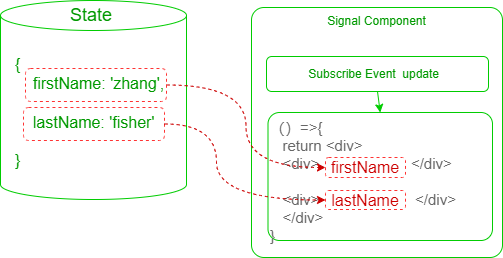Custom rendering
introduce
The function of the status data into a signal component is relatively simple before, so it also provides a custom rendering function. You can perform a more complex appearance or style control when packaging status data packaging as a signal component, and return one to a one.ReactNode type components.

Can Specify the custom rendering function when the status data is directly encapsulated as a signal component the method function signature is as follows:
interface SignalComponentType<State extends Dict>{
<Value=any>(
render:SignalComponentRender, // 渲染函数
path:string | string[], // 状态数据路径,
options?:SignalComponentOptions
):React.ReactNode
}Custom rendering function SignalComponentRender the statement is as follows:
type SignalComponentRenderArgs<Value=any> = AsyncComputedValue<Value>
type SignalComponentRender<Value=any> =(
value:SignalComponentRenderArgs<Value>
)=>React.ReactNodeThe example is as follows:
$(
// 渲染函数
({value,loading,timeout,retry,progress,error})=>{
return <div>{value}</div>
},
// 状态数据的路径
'user.age'
)If it is a state pointing to an asynchronous calculation object AsyncComputedValue, Will be introduced in loading,timeout,retry,progress,error waiting for parameters, so we can perform more rendering control.
Status signal component
In the previous article, we use $ ('<State Path>') will Status data is directly encapsulated as signal components, But lack more control, you can also specify a custom rendering function at this time.
<Value=any>(render:SignalComponentRender,path:string | string[]):React.ReactNodeWill Status data is directly encapsulated as signal components the method of specifying a custom rendering function is as follows:
$(
// 渲染函数
({value})=>{
return <div>{value}</div>
},
// 状态数据的路径
'user.age'
)The following is one $ (Render, '<State Path>') example of custom rendering function:
Asynchronous state signal component
If the status data path is directed to an asynchronous computing object AsyncComputedValue at that time, the object contains loading,error,value properties.
Support for use at this time $ ('<Tiles of asynchronous calculation attributes>') create a signal component.
reminder
$('order.count') and $('order.total.value') it is equivalent. When creating a signal component, if the target is found AsyncComputedValue automatically add value.
Advanced asynchronous signal component
If the target path is an asynchronous calculation attribute, the same one is also used $(<render>,<path>) the method of customizing the rendering, but the parameters of the rendering function at this time are an object AsyncComputedValue including value,loading,error,timeout,retry properties.
Therefore, we can follow loading,error for more attributes, more custom rendering control.